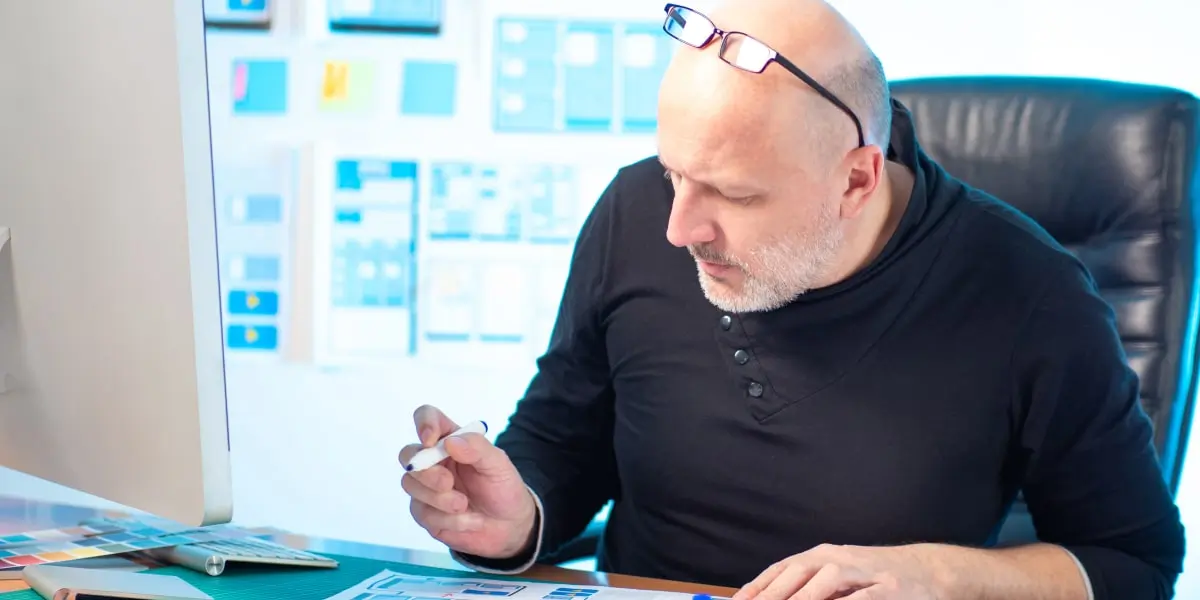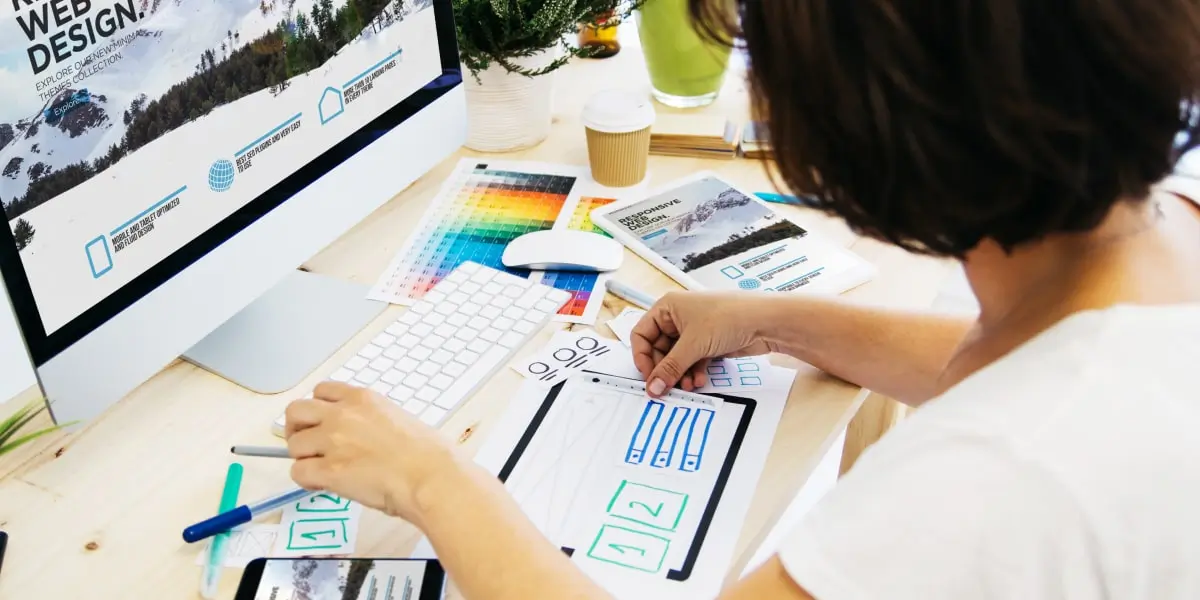The 2019 design census showed something that many might have suspected—that the majority of designers are aged between 20 and 30 years old. A figure like this might leave you questioning whether you are too old to become a UI designer. We have to strongly disagree.
Firstly, since that census was taken, the Covid-19 pandemic and ensuing “Great Resignation” has shaken up the global labor market, and the averages are definitely higher now.
In fact, a recent Zippia study shows that the average age for a UI designer in the United States is 37 years old. While demographics like this are more encouraging, it would, however, be remiss of us to pretend that ageism doesn’t exist in the tech industry.
On the contrary, the tech industry appears to be worse than others, with a 2021 University of Gothenburg study showing that in tech sometimes even over 35 is considered “old”. In the UK, 41% of tech workers reported observing age discrimination, versus 27% in other industries, according to a CWJobs survey.
With all this in mind, why are we so sure it’s not too late to become a UI designer? Well, even though you may come up against different hurdles compared to younger colleagues, successfully changing careers to UI in your 30s, 40s, 50s, and beyond is definitely doable. Plus, there’s a wide range of inherent advantages you’ll find you have which your more inexperienced colleagues won’t (yet).
Let’s get down to it. We’ll get to grips with the obstacles and positives of being an “older” UI designer, how to surmount any barriers linked to age, and how to make it as a UI design success story, regardless of how many years you might have.
This is what we’ll cover:
- The potential difficulties of being an “older” UI designer
- Getting past age-related barriers
- Benefits of being an “older” UI designer
- Final thoughts
1. The potential difficulties of being an “older” UI designer
It can be challenging to make an eye-catching impression while breaking into the UI industry, regardless of age. That said, those with more life experience face particular obstacles at times, whether they’re first arriving in the industry or starting to climb the ladder. Let’s quickly look at those obstacles, as well as how to surmount them.
Getting and staying up-to-date with the latest design trends and technologies
Being honest, this can be an issue for designers at all stages of the industry, such is the fast-moving nature of tech. Experienced pros who have been around the UI block can struggle to move on from tools and trends which worked for them in the past, and to embrace newer technologies.
At the same time, many fledgeling UI designers of any age can feel overwhelmed by the amount of new trends and tools flying at them, each being touted as the future of design. Combining this with the feeling that they aren’t as “techie” as they believe their colleagues are can create the perfect storm of feelings of inadequacy. Help, however, is at hand.
How to beat this challenge: Creating good habits can be the key to keeping on top of the industry. Put aside just a few minutes every day, or block off a few hours each week, to look through UI design blogs or simply check out the latest work of your favorite designers.
Over time, as this becomes an unconscious habit, you’ll also learn to start instinctively sorting the potentially useful and long-lasting UI trends from those which are just a flash in the pan.
Making and building connections with younger colleagues and employers
At first it can be quite intimidating to work with and for people who are from a slightly younger generation than yourself. In tech many companies might have a group who are often perceived as “young and hip” who can be hard to approach.
The same thing works both ways. Younger UI designers might struggle to approach older colleagues because they’re intimidated and unsure of how to go about it, or feel they lack authority.
How to beat this challenge: Actively tackle the issue by taking the initiative. It sounds simple, but that’s why it’s often overlooked among the busyness of starting out as a UI designer. Set aside the time to try and make genuine connections with younger colleagues. Making the effort to do this will help this obstacle fall away.
Finding a suitable salary for yourself
It’s possible that you’re starting out in UI design after already having a successful career elsewhere, which had a higher salary to match.
Faced with a comparatively lower junior UI designer salary, it might be tough considering the financial needs you have. What a 20- or 30-year-old might be able to comfortably get by on may not stand up to the likes of the potential healthcare, mortgage, childcare, or pension costs you face. While progressing to that higher UI designer salary will happen, it can take a bit of patience.
How to beat this challenge: Firstly, make sure to do your research on UI design salaries. This means that you are entering into the field with realistic expectations of what you can expect to earn starting out, as well as where you can go.
On top of this, however, make sure to not let your past work experience go unrewarded in your salary as a UI designer! Take time to pitch it in such a way that shows off your extra worth, and demonstrates how your considerable career and life experience makes you a better designer. Make sure to put the spotlight on your transferable skills—all of this can make sure that you negotiate or aim for the UI designer salary that best accommodates your needs.

Increased life responsibilities and stresses
Regardless of whether you’re trying to snag a job or working towards a promotion to senior UI designer, you could well be going up against younger designers who have fewer obligations. Making your way in the design world can be tough regardless of your situation, but for those with busy lives outside of work it can be more draining.
Family duties and commitments may mean that you are less amenable to relocating for a role (although the increasing rise of remote UI designers means this is less of an issue). Working all night to get a project finished becomes less and less of a good idea as you get wiser.
How to beat this challenge: In terms of maintaining the energy levels necessary to hit your career targets as a UI designer, organizing your time and maintaining an overall healthy balance can be the key. Again, starting and building good habits is key, combined with sensible planning.
Overcoming mental blockers
Issues such as a general lack of self-confidence and impostor syndrome can affect career-changers of all ages, but they can particularly affect those making a switch later in life. Entering an industry like tech, which is filled with colleagues who are in their twenties, can enhance these feelings even more. The possibility of having to tackle ageism in the workplace and manage misconceptions about older designers can present a serious mental barrier.
How to beat this challenge: As we said earlier, while you may tend to be more affected by the likes of impostor syndrome than others, it’s an incredibly common mental blocker, which means lots of help is at hand. There are many different tactics for overcoming impostor syndrome, but for older UI designers it’s important to keep in mind that you’re not alone.
As well as talking about it with your peers (you may find out that your younger colleagues feel like impostors around designers with so much life experience—i.e. yourself!), don’t forget that age is just a number. Keep in mind the value which you bring to the workplace, and place trust in your experience.
2. Getting past age-related barriers
Put simply, obstacles related to age shouldn’t get in the way of your new UI career. To underline this point, we’ve collected some tricks which can be particularly of use to aspiring designers who identify with the issues in this guide.
These best practices should help you master impostor syndrome, figure out the serious value of your transferable skills, and use your experience and expertise to highlight yourself as a designer.
Become a UI design bookworm
This sounds like a pretty obvious step, but its benefits are many. Reading as many UI books and materials as you can get your hands on won’t just further underline why this career-change direction is right for you, but it also will easily signpost to prospective employers that not only do you have the skills, but that you’re also passionate about UI design. Here are just a few to get you started:
Keep up-to-date with UI design blogs, accounts, and other resources
It shouldn’t really matter what stage of your design career you’re at—keeping as on top of the industry as possible is vital. We’re not saying you have to live on the cutting edge all the time—just make sure that you have a habit for monitoring UI design trends. This shows everyone around you that you know what’s happening in the UI community.
To get you started, we have a list of design podcasts to check out and follow. If you want to take this further, you could experiment with new features or tools by creating your own personal projects outside of work.
Go to networking events or meetups, on- or offline
Simply put, while a common suggestion, meetups really are beneficial for older UI designers. Not only do they give you a chance to encounter fellow designers of all ages and stages in their journey, they are also excellent opportunities for facing and overcoming insecurities. One reason networking events include impostor syndrome and other barriers is that there is less pressure on you than in a work environment—the stakes are lower.
Furthermore, the Covid-19 pandemic driving a lot of meetup events online has positives for fledgling UI designers who might have more life responsibilities. Without the need to travel to a physical networking event (typically in a major city), attending these online events is much easier to fit into your schedule. On top of this, the fact that attendees from all over the world can attend, your opportunities to meet other designers at a similar point to yourself increase exponentially.
Lastly, these events could even be a chance for you to meet a mentor, someone who is happy to help guide you through your UI career.
Make sure your portfolio and resume are up-to-date
We don’t just mean that your latest positions and projects should be present and accounted for—we also mean that they should be current with the UI industry. If you feel like your portfolio needs some examples of UI storyboarding, make it a personal project and add it. Think you’re missing animation skills in your repertoire? Then take an animation specialization course on the side and put it on your resume.
If your application materials feel in some ways outdated, this will make them less eye-catching.
Take advantage of your age and previous experience
This tip is one which is vital across your professional appearance as a UI designer: from your resume, to updating your LinkedIn, to your interview prep.
Be absolutely clear about the strengths which you bring to the table. Ensure that prospective employers see how your previous experiences make you a better designer, as well as how effective an addition to a design team you will be.
Keep in mind the benefits your position brings, and make sure to bring up any and all past achievements which may be relevant to the job.

3. Benefits of being an “older” UI designer
While you’re likely to come up against barriers such as age-based discrimination, there are a whole pile of advantages the UI community can gain from designers in their 40s or 50s (or wiser):
Vast and varied work experience
We hear it all the time, but it’s time to start believing it: Having more work experience, even in different industries, is desirable in candidates. Those boasting a longer work history bring more diversity of experience to a job. Part of this diversity is about the valuable perspective you bring with you—something that is vital to UI design.
Companies looking to broaden inclusivity
Following on from the previous point, diversity, equity, and inclusion in workplaces (particularly the tech industry) has finally come under more scrutiny of late. While this is not before time, it does mean that this diversity of perspective that older UI designers bring will be not just welcomed, but sought-after by firms.
Put simply, designers with more life and work experience can design more effectively for user needs that are related to age. However, not only that, but they also tend to be better at noticing and catering for user needs that those with less life experience and empathy won’t notice or be able to understand.
So make sure to remember that your perspective is valuable when it comes to ensuring that we design interfaces with accessibility and inclusion at the fore.
More experience = more soft skills
Particularly in the tech industry, much-vaunted soft skills can help seal the deal when it comes to landing a role. However, for those preparing for or entering the working world in their twenties, these soft skills can take a lot of practice to develop and hone. For older UI designers, this is not an issue.
Sought-after UI soft skills like time management, communication, and empathy come much more easily to those with much more life experience under their belts. On top of these there is also our experience of failure—having suffered more disappointments in life means that we have also learned to deal with them and respond, which improves our resilience.
Final thoughts
Despite the fact that ageism in design is a serious issue, there are lots of opportunities for older UI designers to flourish.
A thirst for knowledge, deeper empathy, a wealth of experience, and perseverance makes designers aged 40 and over key to the success of the field. All of these assets are far more important to employers than your age.
As more and more firms diversify their design teams, the world of user interface design will gain from everything that you bring to the job.
If you’re interested in learning more about starting a career in UI design, these articles might be useful to you:
